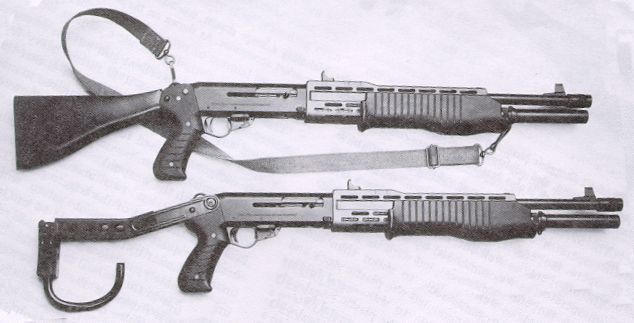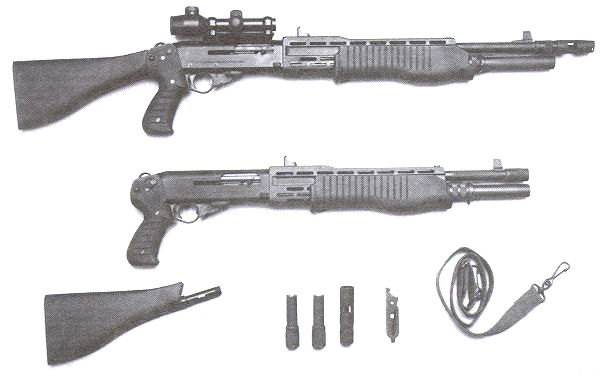Franchi
SPAS
History
Streetsweepers
Article

The
following is excerpted (with permission) from the book Streetsweepers,
The Complete Book of Combat Shotguns by Duncan
Long, published by Paladin Press.
This is an excellent book on all aspects of combat shotguns like the SPAS
-- guns, ammo, tactics, and more. Paladin
Press is a very unique publisher well worth checking out.
FRANCHI SPAS-12
Developed from the earlier SPAS-11 (and
apparently using the action of the PG-80 Franchi shotguns), the SPAS-12
was first introduced in the United States in 1983 by its importer, FIE.
The SPAS-12 operates from a gas system which can be switched off so that
the fore grip can be used to operate the action manually like a pump shotgun,
This allows the user to fire low-power, special rounds in the weapon.
In addition to the folding metal stock,
an optional plastic stock is available from Franchi (through FIE) for the
SPAS-12. Many find the plastic stock more comfortable than the metal stock.
Choate also makes a skeletonized plastic stock which some, especially those
who find the SPAS-12 factory pistol grip too large, will find more comfortable.

The SPAS-1 2 (shown), developed
from the SPAS-11, was first introduced to the United States in 1983 by
its importer, FIE. The SPAS-12 operates from a gas system which can be
switched off so that the fore grip can be used to operate the action manually
like a pump shotgun. This allows the user to fire low-power, special rounds
in the weapon. Upper weapon has the company's fixed stock; lower has the
folding stock with curved carrying-handle accessory. (Photo courtesy of
FIE)
The SPAS- 12 is capable of taking a lot
of abuse and operates in conditions that will make many sporters inoperable.
It is capable of firing a wide range of loads as well but, for best operation,
magnum loads are recommended by the manufacturer. The weapon's weight,
coupled with its gas action, makes it more comfortable to shoot than most
other 12-gauge shotguns with the plastic stock and the gun in the semiauto
mode. (The metal folding stock, like most other metal folders, is ideal
only for those who need a shotgun which can fit into a tight space; firing
from the shoulder with this stock can be very uncomfortable. The folder
also has a detachable carrying handle available for it.)
The shotgun comes with a cylinder-bore
barrel. (Chris's note: Not by any measurements I've made)
Screw-in chokes and a spreader attachment are also available if needed.
The barrel has a pair of sights which are quicker to use than those of
many other deer-gun-style shotguns. The front is a blade sight and the
rear an aperture sight (unfortunately, neither is adjustable). A scope
mount is available from FIE for those who wish to use an Aimpoint or other
scope.

The SPAS-12 shotguns have
a number of available accessories, including a scope mount, screw-in chokes,
a shot-spreader attachment, sling, and adjustment tool, in addition to
several aftermarket accessories. As shown on the lower weapon, the standard
fixed stock is also detachable. (Photo courtesy of FIE)
The SPAS- 12 is an excellent gun but has
several shortcomings, One is that it is rather heavy for carrying any length
of time. (Chris's note: Very heavy) The other
is that the weapon is rather complex when compared to most other shotguns
designed for combat use (however, these complexities can be simplified
once the user is familiar with the weapon).
The firearm has two manual safeties, both
located at the front of the trigger guard. The well designed quick-employment
safety works in a manner similar to that of an M-14 or Garand rifle (unfortunately,
it also acts as a slide release when the gun is in the manual mode -- this
can cause not a little confusion if the user switches back and forth from
one mode to the other very often). When the SPAS-12 is loaded with a shell
in the chamber, pushing forward on the quick-employment safety makes the
gun ready to fire. The second safety blocks the first so that it is impossible
for right-handed shooters to place the quickemployment safety into its
safe position with the trigger finger. (Chris's note:
This is the old, recalled safety) And the second safety is
impossible to rotate without removing one hand or the other from the firing
position, since it has to be rotated 180 degrees to get from safe to fire
position.
The solution to this confusing complexity
of safeties would seem to be to leave the rotary safety off when the weapon
may be needed in a hurry. It is important to note that the quick-employment
safety goes into the off position when the bolt is cycled. Therefore, great
care should be taken to place it on safe position if this were the only
safety used. If the shotgun is carried in this manner and used only in
the semiauto mode, the shotgun isn't as confusingly complex as it may seem
at first. Most shooters will find the SPAS-12 an ideal weapon when used
in such a manner.
On many models, the user should consider
having the dots repainted on the rotary safety if he has one of the SPAS-
12 versions that has a red dot at the safe position and a white one at
fire. This dot coloration on the SPAS- 12 is just the opposite from most
guns and could be confusing if the weapon were used under some low-light
conditions. (Chris's note: Or if you have no dots,
I suggest you add one red dot that is uncovered when not safe. Or
buy the new push-button safety)
The carrier latch button is an aggravation
since it must be depressed to load the magazine. This can make the task
of already-slow reloading even slower. A little gunsmith work could cure
this problem, however.
Switching from serniauto to manual operation
is rather simple: a shrouded button on the underside of the fore-end is
depressed and the fore-end is slid into either the manual or autoload position
(the marker is on the top of the slide). The effort of manually cycling
the pump action is rather heavy because the user must move the disconnected
gas action as well as the operating rods pushing the bolt assembly.
Disassembly is like that of most other
shotguns: the selector is set to the "A" autoloading position, the bolt
is retracted, and the magazine tube is unscrewed and removed along with
the handguard and barrel. The charging handle is held and eased forward
while the carrier button is pressed to ease the bolt forward. While restraining
the bolt and action bars, the charging handle is then pulled out to the
right and the bolt, action bars, and recoil spring eased out of and off
of the front of the shotgun. The trigger assembly can be removed by tapping
out the two drift pins holding it in place.
As it stands now, the SPAS- 12 is a good
combat shotgun if the user dispenses with use of the rotary safety (Chris's
note: Or Installs the pushbutton version), a little gunsmithing
work is done on it, its plastic stock is used, and if its heavy weight
won't pose a problem.
Specifications
Overall length 41 in.
Overall length (stock folded)
3 1 in.
Barrel length 21.5 in.
Weight 9.6 lbs.
Magazine capacity 8 rounds
(Chris's
note: It all depends, see Note 3 at the top of the
SPAS-12
Page)
Back
to SPAS-12 Library
Comments?
Questions? Additions? Corrections?
©1999,2000




